MP Board Class 9th Science Solutions Chapter 5 The Fundamental Unit of Life
The Fundamental Unit of Life Intext Questions
The Fundamental Unit of Life Intext Questions Page No. 59
Question 1.
Who discovered cells and how?
Answer:
Robert Hooke (1665), by chance observed a slice of cork through a self designed microscope. He observed that it contained many little compartments, like a honey comb, which he named as cells. However, Leeuwenhoek (1674) discovered the free living cells in pond water for the first time, by his improved microscope.
![]()
Question 2.
Why is the cell called the structural and functional unit of life?
Answer:
The body of all organisms consists of one or many cells. Therefore, cell is called the structural unit of life. All processes associated with life such as respiration, digestion, excretion etc. are performed by cell. So, cell is also called as functional unit of life.
The Fundamental Unit of Life Intext Questions Page No. 61
Question 1.
How do substances like CO2 and water move in and out of the cell? Discuss.
Answer:
When concentration of CO2 is more inside the cell than outside, CO2 diffuses from the cell to outside of cell. If CO2 concentration inside the cell is less, CO2 moves inside the cell from outside. The water move in and out of the cell by the process of osmosis. Osmosis is the passage of water from a region of high water concentration through semi – permeable membrane (cell membrane) to a region of low concentration of water.
Question 2.
Why is the plasma membrane called a selectively permeable membrane?
Answer:
Plasma membrane permits the entry and exit of some materials in and out of the cell. It also prevents movement of some other materials. So, it is called selectively permeable membrane.
The Fundamental Unit of Life Intext Questions Page No. 63
Question 1.
Fill in the gaps in the following table illustrating differences between prokaryotic and eukaryotic cells.
| Prokaryotic Cell | Eukaryotic Ceil |
| 1. Size: Generally, small (1 – 10 μm). (1 μm = 10-6m). | 1. Size: Generally, large (5 – 100 μm). |
| 2. Nuclear region: ……………… …………………………………………….. …………………… and known as …………. . |
2. Nuclear region: Well – defined and surrounded by a nuclear membrane. |
| 3. Chromosome: Single. | 3. More than one chromosome. |
| 4. Membrane – bound cell organelles absent. | 4. ………………………………………….. . |
Answer:
Prokaryotic cell:
2. Nuclear region is poorly defined due to absence of a nuclear membrane and is known as nucleoid.
Eukaryotic cell:
4. Membrane bound cell organelles are present.
The Fundamental Unit of Life Intext Questions Page No. 65
Question 1.
Can you name the two organelles we have studied that contain their own genetic material?
Answer:
- Mitochondria and
- Plastid (chloroplast).
Question 2.
If the organisation of a cell is destroyed due to some physical or chemical influence, what will happen?
Answer:
Each cell has got certain specific cell organelles. Each cell organelle performs a special function.
e.g.,
- making of new material, removal of waste from the cell, release of energy etc. If the organization of a cell is destroyed, the functioning of the cell organelles will be disturbed, control of the nucleus will be lost. Ultimately, cell will die.
Question 3.
Why are lysosomes known as suicide bags?
Answer:
Lysosome is a membrane bound bag – like cell organelle which contains powerful enzymes. If lysosome bursts, its enzymes eat up (digest) other organelles of its own cell. Therefore, they are known as ‘suicide bags’.
![]()
Question 4.
Where are proteins synthesised inside the cell?
Answer:
Ribosomes.
The Fundamental Unit of Life NCERT Textbook Exercises
Question 1.
Make a comparison and write down ways in which plant cells are different from animal cells?
Answer:
Difference between plant cell and animal cell is given below:
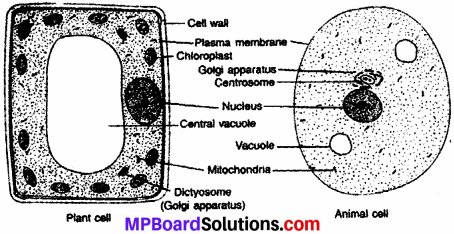
| Plant Cell | Animal Cell |
| 1. The outermost covering of the plant cell is the cell wall which is formed of cellulose. | 1. The outermost covering is the plasma membrane. |
| 2. Plastids (e.g., chloroplast) present. | 2. Plastids absent. |
| 3. Large vacuole present. | 3. No or small vacuoles are present. |
| 4. Centrioles are absent but plastids caps are present. | 4. Centrioles are present within centrosome. |
Question 2.
How is a prokaryotic cell different from a eukaryotic cell?
Answer:
| Prokaryotic Cell | Eukaryotic Cell |
| 1. Cell size is generally small. (1 – 10 mm). | 1. Cell is generally large. (5 – 100 mm). |
| 2. Nuclear region is called nucleoid is not surrounded by a nuclear membrane. | 2. Nuclear material is surrounded by a nuclear membrane. |
| 3. Only a single chromosome is present. | 3. More than one chromosome are present. |
| 4. Nucleolus is absent. | 4. Nucleolus is present. |
| 5. Membrane bound cell organelles are absent. | 5. Cell organelles bounded by membrane are present. |
| 6. Cell division by fission or budding (no mitosis). | 6. Cell division mitotic or meiotic. |
Question 3.
What would happen if the plasma membrane ruptures or breaks down?
Answer:
Plasma membrane regulates the movement of substances in and out of the cell. Due to rupture of plasma membrane, there will be no regulation of the movement of molecules. Secondly, contents of the cell may leak out. Because of these two reasons cell will die.
![]()
Question 4.
What would happen to the life of a cell if there was no Golgi apparatus?
Answer:
Golgi apparatus is connected to ER. It collects simpler molecules from ER and convert them into more complex molecules. These are then packaged in small vesicles and are stored or transported inside or outside the cell. If Golgi apparatus is not present in the cell, all the above processes of modification, storage and tRansportation will not be possible.
Golgi apparatus is also involved in the formation of lysosomes. If there was no Golgi apparatus in the cell, lysosomes would not be formed and hence, foreign materials like bacteria could easily invade and destroy the cell.
Question 5.
Which organelle is known as the powerhouse of the cell? Why?
Answer:
Mitochondria are known as ‘Power House’ of the cell. They are said so because, the energy required for various life activities is released by mitochondria in the form of ATP molecules. The body uses energy stored in ATP for synthesis of new compounds and for mechanical work. As ATP instantly provide energy, they are called energy currency of the cell.
Question 6.
Where do the lipids and proteins constituting the cell membrane get synthesised?
Answer:
- Rough Endoplasmic Reticulum (RER) synthesizes proteins constituting cell membrane.
- Smooth Endoplasmic Reticulum (SER) synthesizes and secretes lipids constituting cell membrane.
Question 7.
How does an Amoeba obtain its food?
Answer:
Amoeba has flexible cell membrane. It enables Amoeba to engulf in food by the process called endocytosis.
Question 8.
What is osmosis?
Answer:
The passage of water from a region of its high concentration through a semipermeable membrane to a region of low water concentration is known as osmosis.
Question 9.
Carry out the following osmosis experiment:
Take four peeled potato halves and scoop each one out to make potato cups. One of these potato cups should be made from a boiled potato. Put each potato cup in a trough containing water. Now,
(a) Keep cup A empty.
(b) Put one teaspoon sugar in cup B.
(c) Put one teaspoon salt in cup C.
(d) Put one teaspoon sugar in the boiled potato cup D.
Keep these for two hours. Then observe the four potato cups and answer the following:
- Explain why water gathers in the hollowed portion of B and C?
- Why is potato A necessary for this experiment ?
- Explain why water does not gather in the hollowed out portions of A and D.
Answer:
- Water gathers in the hollowed portion of B and C because:
- Living plasma membrane of potato cells act as semipermeable membrane.
- There is higher concentration of water in trough than the hollowed portion of B and C.
- So, water by the process of osmosis moves into hollowed portion of potato cups B and C.
- Potato cup A is kept empty to act as control set – up.
-
- As the potato cup A, is empty, water does not gather in hollowed out portions of A.
- In the potato cup D, the potato cell membrane lost quality of semi – permeability due to boiling. So, no water movement occurs from the trough into the potato cup D.
The Fundamental Unit of Life Additional Questions
The Fundamental Unit of Life Multiple Choice Questions
Question 1.
Who coined the term protoplasm for the fluid substance of the cell?
(a) J.E. Purkinje
(b) Robert Brown
(c) W. Flemming
(d) Robert Hooke.
Answer:
(a) J.E. Purkinje
Question 2.
Ribosomes are the centre for __________.
(a) Fat synthesis
(b) Protein synthesis
(c) Starch synthesis
(d) Sugar synthesis.
Answer:
(b) Protein synthesis
Question 3.
The complete break down of glucose in presence of oxygen in a cell takes place in __________.
(a) Mitochondria
(b) Ribosome
(c) Chloroplast
(d) None of these.
Answer:
(a) Mitochondria
Question 4.
Lysosomes contains __________.
(a) Fats
(b) Secretory glycoproteins
(c) Hydrolytic enzymes
(d) RNA.
Answer:
(c) Hydrolytic enzymes
![]()
Question 5.
Plant cells have large vacuoles each surrounded by a membrane known as __________.
(a) Plasma membrane
(b) Cell wall
(c) Leucoplast
(d) Tonoplast.
Answer:
(d) Tonoplast
Question 6.
The process of selective movement of substances through semi – permeable membrane is called?
(a) Osmosis
(b) Diffusion
(c) Plasmolysis
(d) Imbibition.
Answer:
(a) Osmosis
Question 7.
What makes to withstand greater changes in the surrounding medium in animal cell?
(a) Plasma membrane
(b) Cell wall
(c) Vacuoles
(d) Plastids.
Answer:
(b) Cell wall
Question 8.
When an animal cell is placed in hypotonic solution, it __________.
(a) Swells up
(b) Shows plasmolysis
(c) Bursts due to over swelling
(d) Shows crenation.
Answer:
(c) Bursts due to over swelling
Question 9.
Which of the following maintains the basic structure (shape) of the plant cell after shrinkage of the cell content during plasmolysis?
(a) Plasma membrane
(b) Vacuole
(c) Plastids
(d) Mitochondria.
Answer:
(d) Mitochondria.
Question 10.
Plasmolysis occurs due to __________.
(a) Endosmosis
(b) Exosmosis
(c) Absorption
(d) None of these.
Answer:
(b) Exosmosis
Question 11.
Who among the following scientists coined the term ‘cell’?
(a) Leeuwenhoek
(b) J.E. Purkinje
(c) Robert Hooke
(d) Robert Brown.
Answer:
(c) Robert Hooke
Question 12.
Which is the largest cell in human body?
(a) Muscle cell
(b) Nerve cell
(c) Kidney cell
(d) Liver cell.
Answer:
(b) Nerve cell
Question 13.
Iodine solution is used to __________.
(a) Stain onion peel cells
(b) Stain human cheek cells
(c) Mount onion peel cells
(d) Mount human cheek cells.
Answer:
(a) Stain onion peel cells
Question 14.
The barrier between the cytoplasm and the outer environment in an animal cell is __________.
(a) Tonoplast
(b) Nuclear membrane
(c) Cell wall
(d) Plasma membrane.
Answer:
(d) Plasma membrane.
Question 15.
The power house of a cell is known as __________.
(a) Golgi apparatus
(b) Chloroplast
(c) Mitochondrion
(d) Vacuole.
Answer:
(c) Mitochondrion
Question 16.
Which of the following organelles possesses its own DNA and Ribosomes?
(a) Mitochondria
(b) Lysosomes
(c) Golgi apparatus
(d) Endoplasmic reticulum.
Answer:
(a) Mitochondria
![]()
Question 17.
The functions of which of die organelle include the storage, modification and packaging of products in vesicles:
(a) Lysosome
(b) Vacuoles
(c) Golgi apparatus
(d) SER.
Answer:
(c) Golgi apparatus
Question 18.
Which organelles, like mitochondria, have their own DNA and ribosomes?
(a) Golgi apparatus
(b) Vacuoles
(c) Endoplasmic reticulum
(d) Plastids.
Answer:
(d) Plastids.
Question 19.
Mitochondria and plastids are able to synthesis some of their own proteins because they have?
(a) DNA and nucleolus
(b) RNA and lysosomes
(c) DNA and ribosomes
(d) RNA and ribosomes.
Answer:
(c) DNA and ribosomes
Question 20.
Stroma is present in __________.
(a) Mitochondria
(b) Leucoplast
(c) Endoplasmic reticulum
(d) Lysosomes.
Answer:
(b) Leucoplast
Question 21.
Which of the following cell organelle is called suicide bag of a cell?
(a) Mitochondria
(b) Lysosome
(c) Plastids
(d) Golgi apparatus.
Answer:
(b) Lysosome
Question 22.
Which of the following molecules is known as the energy currency of the cell?
(a) RNA
(b) DNA
(c) ATP
(d) Aminoacid.
Answer:
(c) ATP
Question 23.
ATP stands for __________.
(a) Adenosine triphosphate
(b) Amino triphosphate
(c) Amino triglycerophosphate
(d) Adeninetri – phosphoglyceride.
Answer:
(a) Adenosine triphosphate
Question 24.
Which cell organelle is involved in the formation of lysosomes?
(a) Mitochondria
(b) Golgi apparatus
(c) Plastids
(d) Endoplasmic reticulum.
Answer:
(d) Endoplasmic reticulum.
![]()
Question 25.
Which cell organelle plays a crucial role in detoxifying many poisons and drugs?
(a) RER
(b) SER
(c) RNA
(d) DNA.
Answer:
(b) SER
The Fundamental Unit of Life Very Short Answer Type Questions
Question 1.
Which is the longest flowering plant cell?
Answer:
The fibre.
Question 2.
Which is the longest animal cell?
Answer:
The nerve cell.
Question 3.
Name any two single celled animals.
Answer:
Amoeba, paramoecium and euglena etc.
Question 4.
Which is the largest animal cell?
Answer:
An ostrich egg.
Question 5.
Which is the smallest animal cell?
Answer:
Pleuro Pneumonia like organisms (PPLO).
Question 6.
What are cell organelles?
Answer:
The functional units of cell.
Question 7.
Name the process involved in the movement of O2 in and out of the cell.
Answer:
Diffusion.
Question 8.
Which is the outer most covering of the plant cell?
Answer:
Cell wall.
![]()
Question 9.
Name is the outer most covering of an animal cell.
Answer:
Plasma membrane.
Question 10.
Which is the largest plant cell?
Answer:
Acetabalaria.
Question 11.
Is plasma membrane living or dead?
Answer:
Living.
Question 12.
Name the process involved in the movement of water from outside into the cell.
Answer:
Osmosis.
Question 13.
By which process CO2 and water (H2O) move in and out of the cell?
Answer:
CO2 by diffusion and water (H2O) by osmosis.
Question 14.
Is cell wall living or dead?
Answer:
Dead.
Question 15.
Name the control centre of the cell.
Answer:
Nucleus is the control centre of the cell.
Question 16.
What is the function of ribosomes?
Answer:
Ribosomes are involved in protein synthesis.
Question 17.
Name the site of photosynthesis.
Answer:
Chloroplast.
Question 18.
Which organelles are called
- powerhouse of cell
- suicide bags
- Kitchen of the cell?
Answer:
- Mitochondria
- Lysosome and
- Chloroplasts.
Question 19.
Which organelle makes endoplasmic reticulum rough?
Answer:
Ribosomes.
Question 20.
Name the scientists who formed primitive microscope in the 17th century.
Answer:
Robert Hooke (1665) formed primitive microscope.
Question 21.
Name the plastid which stores starch, oils and protein granules.
Answer:
Leucoplast.
Question 22.
Name the main substance which nucleolus consists of.
Answer:
Nucleolus, found in nucleus, mainly consists of RNA (Ribonucleic acids).
Question 23.
What are genes?
Answer:
Genes are segments of DNA present linearly on chromosomes. They are the functional units of chromosomes.
![]()
Question 24.
What is cytoplasm?
Answer:
The cytoplasm is the fluid content inside the plasma membrane. It contains many specialised cell organelles.
Question 25.
Where are centrioles found?
Answer:
Centrioles are found in centrosome of an animal cell only.
The Fundamental Unit of Life Short Answer Type Questions
Question 1.
Define diffusion.
Answer:
The spontaneous movement of a substance from a region of its high concentration to Che region where its concentration is low, is called diffusion.
Question 2.
Observe the following diagram and answer the questions given below:
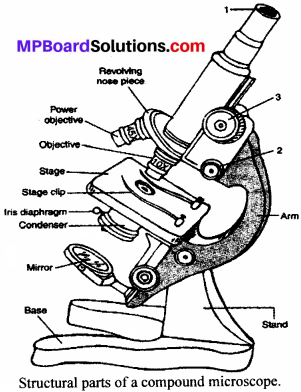
- What is the name of this instrument?
- What are the names of the parts marked as 1, 2 and 3 ?
- There are two objectives, one is marked as 45X and second one as 10X. Under which objective you would first view the onion peel cells ?
Answer:
- Compound microscope.
-
- Eye piece
- Fine adjustment screw
- Coarse adjustment screw.
- Under 10X objective (low power objective).
Question 3.
What is the function of cell wall and plasma membrane?
Answer:
- Cell wall: Gives rigidity, shape and protection to plant cell.
- Cell membrane: Allows only selected materials to move in and out of the cell.
Question 4.
Define osmosis.
Answer:
The passage of water from a region of higher concentration to a region of lower concentration through a semipermeable membrane is called osmosis.
Question 5.
What is chromatin material?
Answer:
Inside the nucleus a tangled mass of thread – like structure is present which is called chromatin material. It mainly consists of DNA (deoxyribonucleic acid) and protein.
Question 6.
What is the function of centrosome? Name the structure found in plant cell to do the same function.
Answer:
Centrosome helps in cell division in animal cells. The polar caps perform the same function in a plant cell.
![]()
Question 7.
What is the function of Mitochondria?
Answer:
In mitochondria, digested food is broken down to release energy. This released energy is stored in the form of ATP.
Question 8.
What is plasmolysis?
Answer:
When a living plant cell loses water through osmosis, there is shrinkage or contraction of the protoplasm away from the cell wall. This phenomenon is called plasmolysis.
Question 9.
What is endocytosis? Give one example.
Answer:
The process in which a cell due to flexible cell membrane engulfs in food and other material from its external environment is known as endocytosis. Amoeba acquires its food through this process.
Question 10.
Who discovered cells in living organisms? Give an example of unicellular organism.
Answer:
Leeuwenhoek (1674) observed free living cells in pond water for the first time. Example of unicellular organisms: Amoeba, chlamydomonas, paramoecium, bacteria etc.
Question 11.
What is the location and main component of cell wall?
Answer:
Cell wall is a rigid structure found outside the plasma membrane of the plant cells. Cellulose (a fibrous polysaccharide) is the main constituent of the cell wall.
Question 12.
What are chromosomes?
Answer:
Chromosomes are rod – shaped structures found in the nucleus of the cell. Chromosome contain information for inheritance of features from parents to next generation in the form of DNA molecule.
Question 13.
What is a eukaryotic cell?
Answer:
A cell that has a definite nucleus with nuclear membrane and also contains membrane bound organelles in its cytoplasm is called eukaryotic cell.
Question 14.
What is nucleoid?
Answer:
In prokaryotes, due to absence of nuclear membrane, nuclear region of the cell is poorly defined. This kind of undefined nuclear region containing only nucleic acid is called a nucleoid.
Question 15.
Give two examples of prokaryotic organisms.
Answer:
Bacteria and cyanobacteria (blue green algae)
e.g.,
- Nostoc are prokaryotic unicellular organisms.
Question 16.
What is a prokaryotic cell?
Answer:
A cell which lacks nuclear membrane, contains a single chromosome and also lacks membrane bound organelles is called prokaryotic cell.
Question 17.
What is cytoplasm?
Answer:
The part of protoplasm which remains after excluding nucleus, is known as cytoplasm. Cytoplasm contains an aggregate molecules of various chemicals and cell organelles. Most of the biochemical reactions such as protein synthesis, release of energy etc. take place in cytoplasm or organelles present in the cytoplasm.
Question 18.
Write three main points of cell theory as expressed by Schleiden, Schwann and Virchow.
Answer:
Cell Theory: Schleiden and Schwann proposed that:
- all the plants and animals are composed of cells and that
- the cell is the basic unit of life. Later on, Virchow added that
- all cells arise from pre – existing cells.
Question 19.
List four major functions of a cell.
Answer:
Functions of Cell:
- Synthesis of substances.
- Digestion (lysis) of substances.
- Generation of energy for vital functions.
- Secretion.
Question 20.
What is the function of an endoplasmic reticulum?
Answer:
Endoplasmic reticulum helps in the transport of substances between various regions of the cytoplasm or between the cytoplasm and the nucleus. Endoplasmic reticulum also functions as a cytoplasmic framework providing a surface for some of the biochemical activities of the cell. In vertebrates, SER present in the liver cells also plays an important role in detoxifying poisons and drugs.
![]()
Question 21.
What is lacking in a virus which makes it dependent on a living cell to multiply?
Answer:
Viruses lack selectively .permeable plasma membrane and cell organelles. Thus, they lack a basic structural organisation to perform various life processes effectively and in their own way. After entering a living cell, a virus utilises its own genetic material and machinery of host cell to multiply.
Question 22.
Write one function of each:
- rough endoplasmic reticulum and
- smooth endoplasmic reticulum.
Answer:
- Rough endoplasmic reticulum (RER) has ribosomes on its surface for synthesizing proteins.
- Smooth endoplasmic reticulum (SER (without ribosomes) secrete lipids or fats. Some of the proteins and lipids help in building cell membranes.
Question 23.
What is membrane biogenesis?
Answer:
The SER (Smooth Endoplasmic Reticulum) synthesises certain proteins and lipids which help in building the plasma membrane. This building of plasma membrane by SER products is called membrane biogenesis.
Question 24.
What are the leucoplasts and their functions?
Answer:
- Leucoplasts: These are colourless plastids which do not contain any pigment.
- Function: Leucoplasts are involved in formation and storage of starch, oil drops and proteins granules.
- For example: Amyloplasts found in potato tuber store starch.
Question 25.
Why mitochondria are referred to as strange organelles?
Answer:
Mitochondria have their own DNA and ribosomes. Therefore, they can make some of their own proteins. So, sometimes they are referred as ‘strange organelles’. On the other hand, they help in cellular respiration and formation of ATP.
Question 26.
Expand the term ATP. What is use of ATP?
Answer:
ATP stands for Adenosine triphosphate.
Use:
ATP molecules are rich in chemical energy. The body cells use the energy stored in ATP for synthesis of new chemical compounds, their transport and for mechanical work done by cells / tissues.
Question 27.
What are plastids?
Answer:
Plastids are double membrane bounded structures which are found in plant cells only. Inside the plastid, a fluid material called stroma is present. In stroma, numerous membrane layers remain scattered. Plastids like mitochondria do not have cristae. They also have extra – nuclear DNA. There are two types of plastids: Leucoplasts and Chromoplasts.
Question 28.
What type of enzymes are present in the lysosomes? What is their functions? Which organelles membrane manufacture these enzymes?
Answer:
- Lysosomes contain powerful digestive enzymes capable of breaking down all organic material.
- Lysosomes help to keep the cell clean by digesting worn out cell organelles and foreign material such as bacteria or food.
- RER (Rough Endoplasmic Reticulum) makes the digestive enzymes present in the lysosomes.
![]()
Question 29.
What are the three functional regions of cell?
Answer:
The functional regions of all cells are:
- The plasma membrane
- The nucleus and
- The cytoplasm.
Question 30.
What are vacuoles?
Answer:
Vacuoles are fluid – filled structures surrounded by a membrane known as tonoplast. The fluid in the vacuoles is called cell sap. In animal cells either they are absent or are very small in size but can be many. In most plant cells, vacuole is big and centrally placed which provides turgidity and rigidity to cells.
The Fundamental Unit of Life Long Answer Type Questions
Question 1.
What will happen if an animal or plant cell is put into a solution of sugar and water?
Answer:
The following three things could happen:
- If the solution surrounding the cell is very dilute than cytoplasm, the water will move into the cell, i.e., the cell will gain water.
- If the solution has exactly similar water concentration as that of cytoplasm of cell, there will be no net movement of water across the cell membrane, i.e., no gain or loss of water from the cell.
- If the medium (solution) has a lower concentration of water than the cell i.e., the solution is concentrated, the cell will lose water by osmosis.
Question 2.
What will happen when
- an egg without shell is placed in concentrated salt solution for 5 minutes?
- an egg without shell is placed in pure I distilled water for 5 minutes? Give reason in brief.
Answer:
- The egg loses water and shrinks.
- Reason: The egg membrane acts as semipermeable membrane. The concentrated salt solution present outside the egg is hypertonic so the egg loses water by osmosis.
- The egg gains water and swells.
- Reason: The pure water is hypotonic (dilute) than egg cells, so water from the outside moves into the egg cells by osmosis. The gain of water results in swelling of egg.
Question 3.
What is the significance of cell wall in plant cell?
Answer:
It performs the following functions in the plant cell:
- It gives a definite shape to the cell.
- It provides rigidity and strength to the cell.
- It protects the plasma membrane and inner cell organelles by bounding the cell from outside.
- It allows cells of plants, fungi and bacteria to withstand very dilute external media without bursting.
- It helps in transport of the material in and out of the cell.
- Cell wall maintains the shape of the cell when cytoplasm shrinks away from cell wall during plasmolysis.
- It prevents desiccation of cells.
Question 4.
Explain the structure of nucleus.
Answer:
Nucleus is the control centre of the cell. It is covered by a double layered envelope called nuclear membrane. The nuclear membrane has pores which allow the transfer of material from inside the nucleus to cytoplasm. Inside the nuclear membrane an entangled mass of thread – like structures is present. This is called chromatin material (see Fig. given).
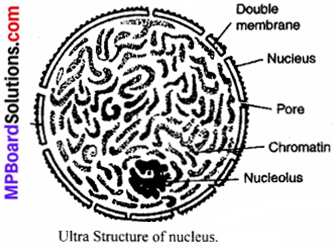
The chromatin material mainly formed of DNA (deoxyribonucleic acid) and proteins. When a cell starts to divide, chromatin material condenses into rod – shaped structures called chromosomes. The chromosomes contain stretches of DNA which are called genes.
Question 5.
Name the cell organelle which are known as:
- Control centre of the cell.
- Demolition squads / suicidal bags of the cell.
- Export firms.
- Power house of the cell.
- Kitchen of the cell.
- Internal transport system.
Answer:
- Nucleus.
- Lysosomes.
- Golgi bodies.
- Mitochondria.
- Chloroplast.
- Endoplasmic reticulum.
Question 6.
What is endoplasmic reticulum? Write its main functions.
Answer:
Endoplasmic reticulum. It is a membranous network. enclosing a fluid – filled lumen. Its main functions are:
- Synthesis of proteins (Rough ER).
- Synthesis of lipids and other metabolic products and their secretion (SER).
- Helps in formation of cell plate and nuclear membrane during cell division.
- ER also produces substance for new cellular parts (especially cell membrane).
- ER provides internal support (Mechanical support) to the colloidal cytoplasmic matrix of the cell.
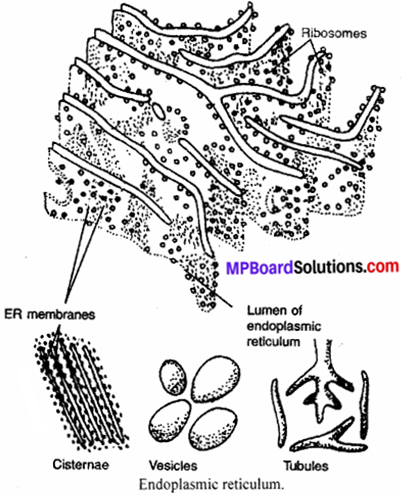
Question 7.
(a) What would happen to the life of a cell if there was no Golgi apparatus?
(b) Which cell organelle detoxifies poisons and drugs in the liver of vertebrates?
Answer:
(a) Golgi apparatus is connected to ER. It collects simpler molecules from ER and convert them into more complex molecules. These re then packaged in small vesicles and are stored or transported inside or outside the cell. If Golgi apparatus is not present in the cell, all the above processes of modification, storage and transportation will not be possible. Golgi apparatus is also involved in the formation of lysosomes. If there was no Golgi apparatus in the cell, lysosomes would not hr formed and hence foreign materials like bacteria could easily invade and destroy the cell.
(b) Try yourself.
Question 8.
Briefly explain the structure of Golgi apparatus.
Answer:
Golgi apparatus is also known as Golgi body or Golgi complex. It consists of a set of smooth, flattened membranous sac like structures called cisternae. These are placed one above the other (staked) in parallel rows.
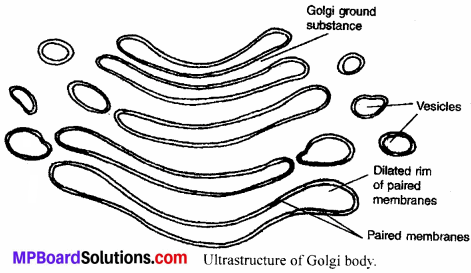
On the outer edge of cisternae (stacks of membrane), tubules and vesicles (small sacs) are present. In plant cells, the Golgi apparatus consists of many unconnected units called dictyosomes.
Question 9.
What are the functions of Golgi apparatus?
Answer:
Functions of Golgi apparatus:
- Golgi apparatus is the secretory organelle of the cell. It packages and dispatches the material synthesized in the cell to intracellular (plasma membrane and lysosomes) and extracellular targets.
- Golgi complex is also involved in the formation of lysosomes.
- Golgi apparatus is also involved in the synthesis of many substances such as polysaccharides, glycoproteins etc.
Question 10.
What are lysosomes?
Answer:
Lysosomes: These are membrane bound vesicles which bud off from Golgi apparatus. They contain powerful enzymes capable of digesting or breaking down all organic material. The enzymes present in lysosome are synthesised on RER.
The membrane that bound lysosomes does not allow the enclosed enzymes to pass freely into the cell cytoplasm. Thus, protects the cell from autolysis (self – dissolution or breakdown). They are absent in RBCs and a few plant cells
for example:
- yeast
- fungi and
- green algae.
![]()
Question 11.
Describe the role played by the Lysosomes. Why are these termed as suicidal bags? How do they perform their function?
Answer:
Functions of Lysosomes:
- Extracellular digestion: Sometimes lysosome enzymes are released outside the cell to break down extracellular material.
- Digestion of foreign material: Lysosomes also destroy any foreign material which enters inside the cell such as bacteria.
- Cellular digestion: In damaged cells, ageing cells or dead cells lysosomes get ruptured and enzymes are released. These enzymes digest their own cell.
Lysosomes contain about 40 hydrolytic enzymes. When the cell gets damaged, lysosomes burst and their enzymes digest their own cell. So, lysosomes are called ‘suicide bags’. Foreign materials entering the cell, such as bacteria or food, as well as old organelles end up in the lysosomes, which break them up into small pieces.
Question 12.
Describe the structure of mitochondria.
Answer:
Mitochondria are rod – shaped cell organelle found in the cytoplasm. Each mitochondrion (singular of mitochondria) is a double membrane bound structure. The outer membrane of mitochondrion is smooth. But the inner membrane of the mitochondrion is folded inwardly, into the matrix of mitochondrion forming finger – like projections.
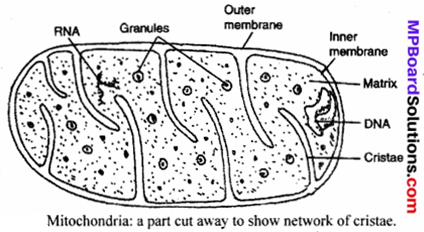
The inward finger – like projections of inner membrane are called cristae. Cristae greatly increase the surface area of the inner membrane. Mitochondria contain extra – nuclear DNA.
Question 13.
What are chromoplasts and leucoplasts? Give an example of chromoplasts which has green pigment.
Answer:
Chromoplasts are coloured plastids i.e., they may contain pigment of different colours. For example, Blue green chromoplasts found in blue green algae.
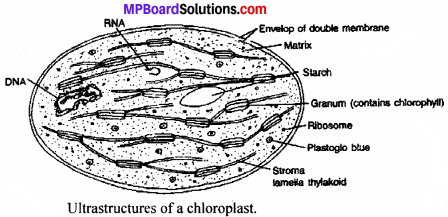
The most important chromoplasts are chloroplasts which contain green pigment, known as chlorophyll. Chloroplasts are very important for photosynthesis. Other non – green chromoplasts are responsible for characteristic colour of flowers and fruits.
- Leucoplast: These are colourless plastids which do not contain any pigment.
- Function: Leucoplasts are involved in formation and storage of starch, oil drops and proteins granules.
- For example: Amyloplasts found in potato tuber store starch.
Question 14.
(a) Name the organelle which provides turgidity and rigidity to the plant cell. Name any two substances which are present in it.
(b) How are they useful in unicellular organisms?
Answer:
(a) Plant cells have big vacuoles full of cell sap that provide them turgidity and rigidity. Plant vacuoles store amino acids, sugars, various organic acids and some proteins.
(b) In unicellular organisms they may serve the following purposes:
- Forming food vacuoles: In single celled organisms like Amoeba, the food vacuole contains the food items that the Amoeba has ingested. The food items are digested by the enzymes later on.
- Removal of excess water and wastes: In some unicellular organisms, specialised vacuoles play important roles in expelling excess water and some wastes from the cell.
The Fundamental Unit of Life Higher Order Thinking Skills (HOTS)
Question 1.
When we take bath for long time, the skin of our fingers shrink. Give reason.
Answer:
The soaps used are hypertonic as compared to the osmotic concentration of our skin. Exosmosis in skin cells occurs resulting in shrinking of skin of fingers.
![]()
Question 2.
‘The Golgi apparatus is also called the secretary organelle of the cell’. Why?
Answer:
Golgi apparatus is called so as its main function is secretion. The secretary proteins and lipids are packed and released on the surface by Golgi via exocytosis.
The Fundamental Unit of Life Value Based Questions
Question 1.
Manjeet is a five year old boy who joined the swimming classes. After the first class, he was worried when he saw his wrinkled fingers. He asked his elder brother about the wrinkling and shrinking of his fingers. His brother explained Manjeet, why it was so.
- Why did the fingers wrinkle after swimming?
- What caused the shrinking / wrinkling of fingers?
- What value of Manjeet is seen in the above case?
Answer:
- Fingers wrinkled because the cells of the skin lost some water.
- This happened because of the difference in the concentration of water in the skin cells and swimming pool’s water.
- Manjeet showed the value of aware person and a good learner who clarifies the doubts.
Question 2.
Kalyan’s mother wanted to use some eggs for incubation. Kalyan helped his mother in separating rotten and spoilt eggs from the good ones. He took a bucket of water to separate them.
- How can one separate the rotten eggs from the good ones using water?
- What is the shell of an egg made up of?
- What value of Kalyan is seen in this act?
Answer:
- We can separate the rotten eggs by dipping them in water. The eggs that will float in water are rotten eggs and those that sinks are good one.
- The shell of an egg is made up of calcium carbonate.
- Kalyan showed the value of being helpful and responsible.